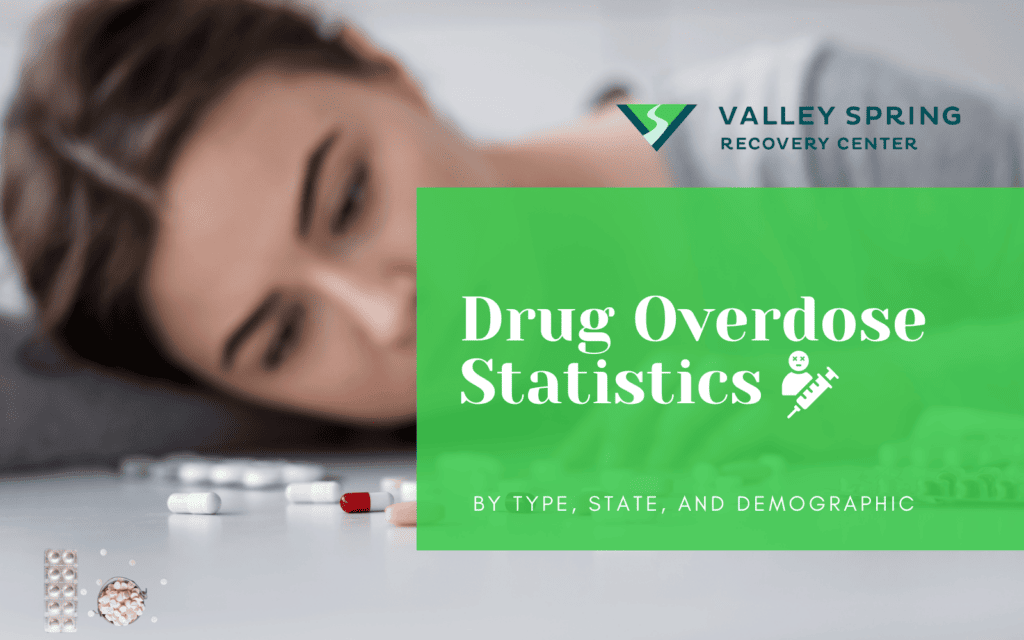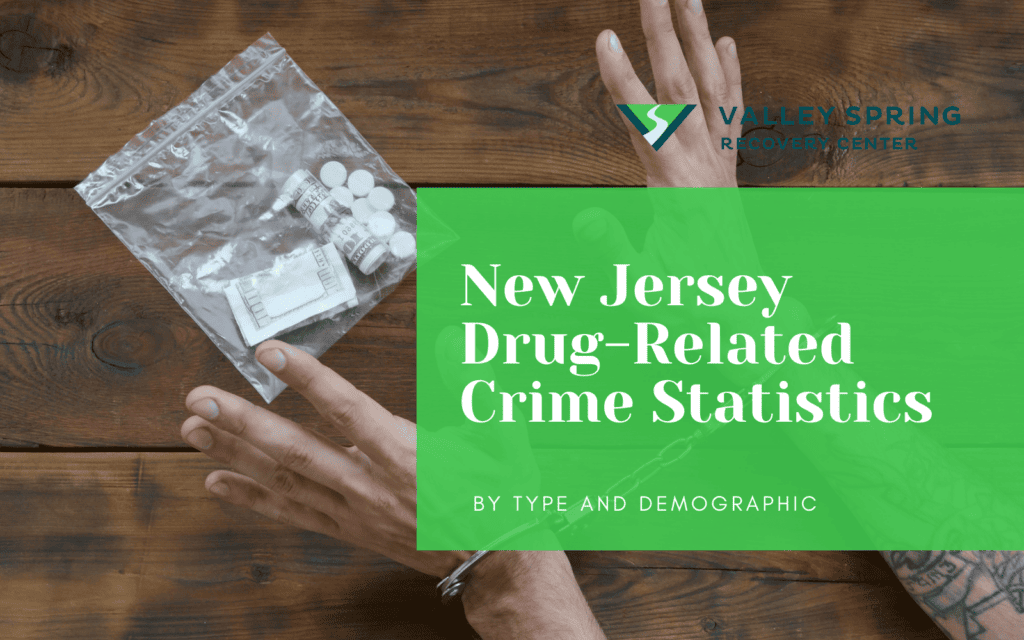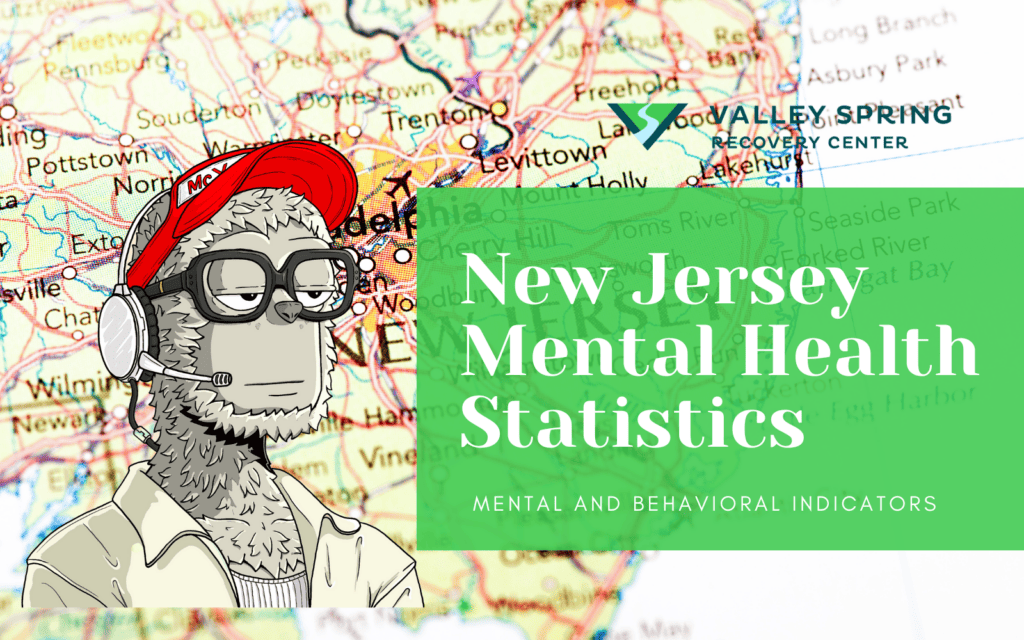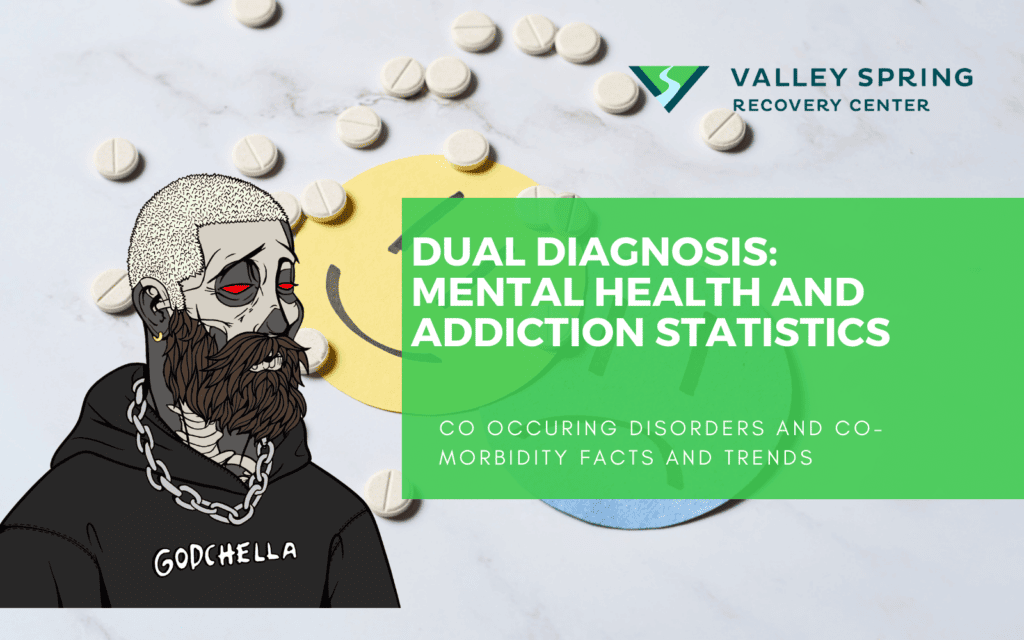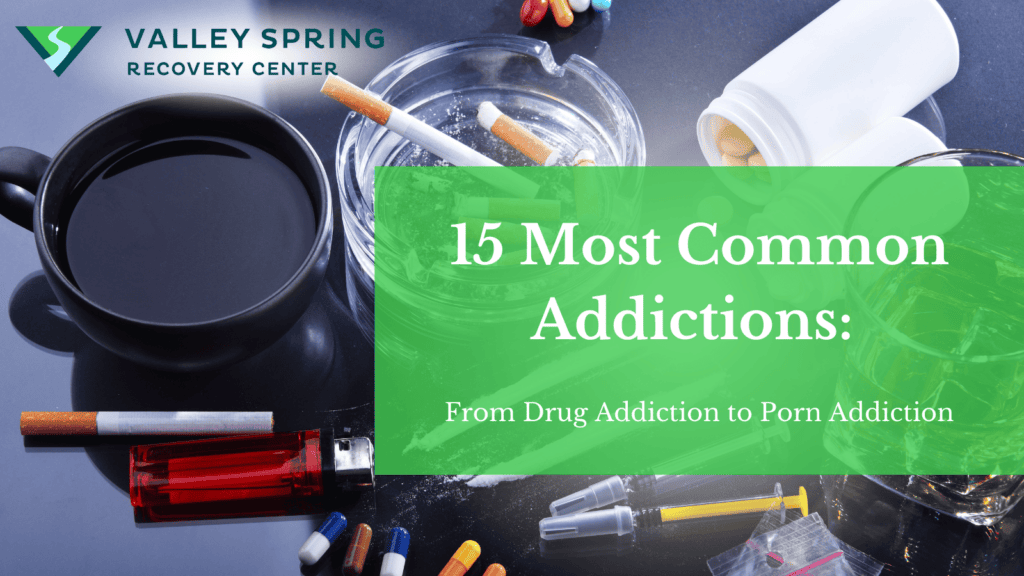Addiction in the workplace, including alcoholism and drug addiction, presents multifaceted challenges that affect not only the individuals involved but also the overall health of businesses. The Substance Abuse and Mental Health Services Administration (SAMHSA) estimates these challenges cost U.S. businesses approximately $81 billion annually. This staggering figure stems from a combination of lost productivity, increased healthcare expenditures, and lost work hours.
Employees with addiction issues are typically less productive, more likely to utilize sick leave, face a greater risk of workplace accidents, and are often involved in more worker’s compensation claims. The infiltration of substance abuse into a professional setting compromises not only individual performance but also jeopardizes workplace safety, legal compliance, and team dynamics.
The prevalence of substance abuse across various industries significantly impacts organizational operations, leading to substantial economic consequences. These include elevated healthcare costs due to addiction-related illnesses, higher rates of absenteeism, and overall reduced productivity. Together, these factors contribute to the financial burdens faced by employers due to substance abuse in the workplace.
Recognizing the signs of addiction is crucial for employers. Effective prevention strategies can mitigate these issues and include implementing educational programs, establishing clear substance abuse policies, and fostering supportive workplace environments that promote health and safety. Additionally, Employee Assistance Programs (EAPs) and specialized counseling services play pivotal roles in supporting employees dealing with addiction, helping them recover in a dignified and supportive manner and reintegrating them into the workforce as valuable members.
Understanding and addressing the complexities of workplace addiction is essential for creating a productive, safe, and healthy work environment that enhances both individual and corporate success.
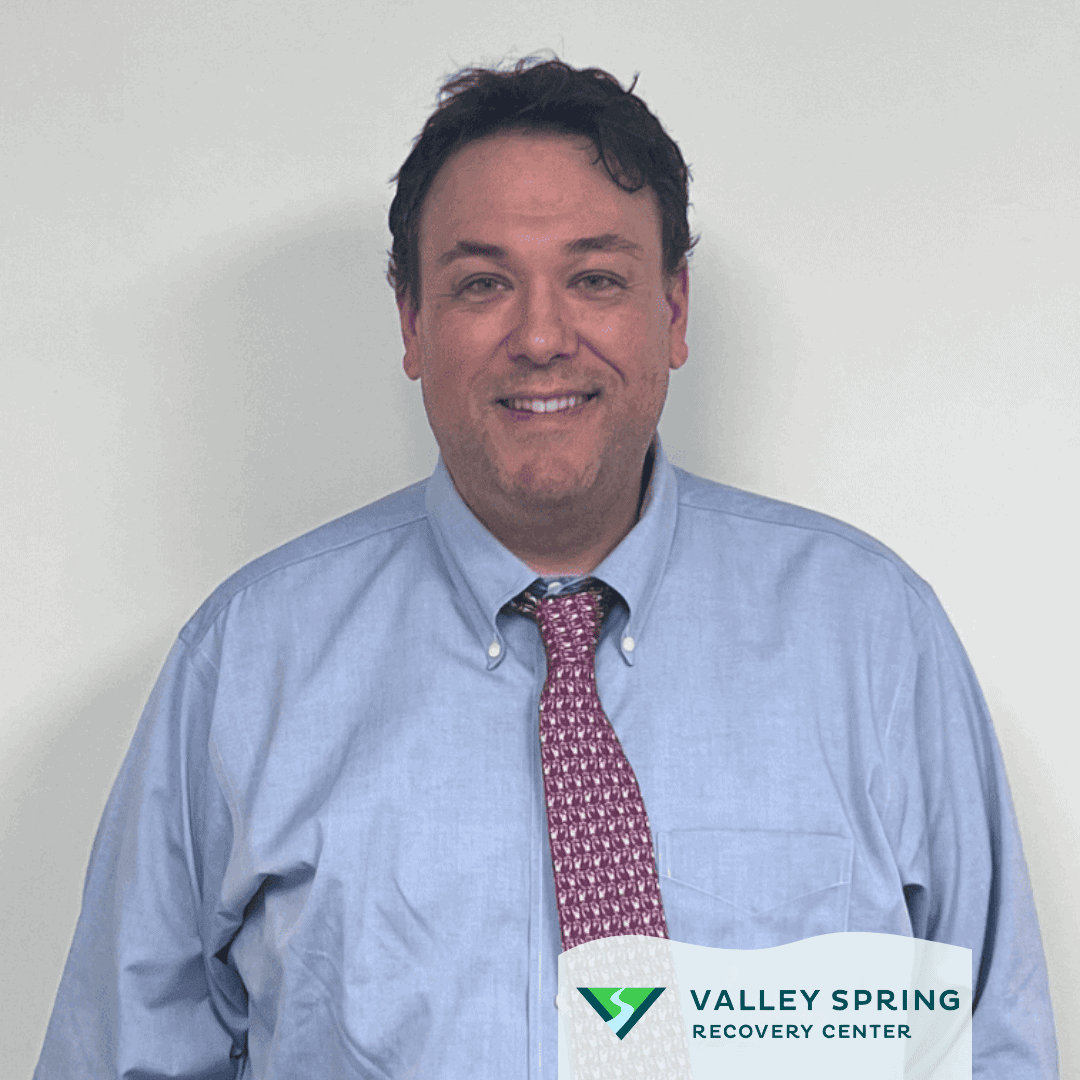
This article has been enhanced with input from the Medical Director and Addiction Psychiatrist at Valley Spring Recovery Center, Dr. Michael Olla.
Check the end of each section for extra information from him.
What Is The Impact of Substance Abuse in the Workplace?
The impact of substance abuse in the workplace is highly detrimental to the individual and the company, where the bottom line is a priority. Employers are also faced with anxiety over the welfare of their staff, both those with substance use problems and those who work with them. A SAMSHA study shows among full-time workers with a past-year SUD, 60.3 percent had an alcohol use disorder, 24.1 percent had an illicit drug use disorder, and 15.6 percent had both. It’s estimated that 70% of Americans who use illegal drugs are currently employed.
8.7 percent of full-time workers aged 18 to 64 reported having a substance use disorder (SUD) in the past year. This alarming figure showcases the widespread nature of the issue and its potential impact on the workforce.
SAMSHA
Problems related to substance abuse include:
- Inefficiency, lethargy, disinterest
- Interpersonal issues
- Poor decision-making
- Distraction and inattention
- Tardiness or sleeping at work
- Poor staff morale
- High staff turnover
- Training expenses for new staff
- Theft or illegal activities
- Disciplinary hearings
How does substance abuse affect workplace safety, productivity, and healthcare costs?
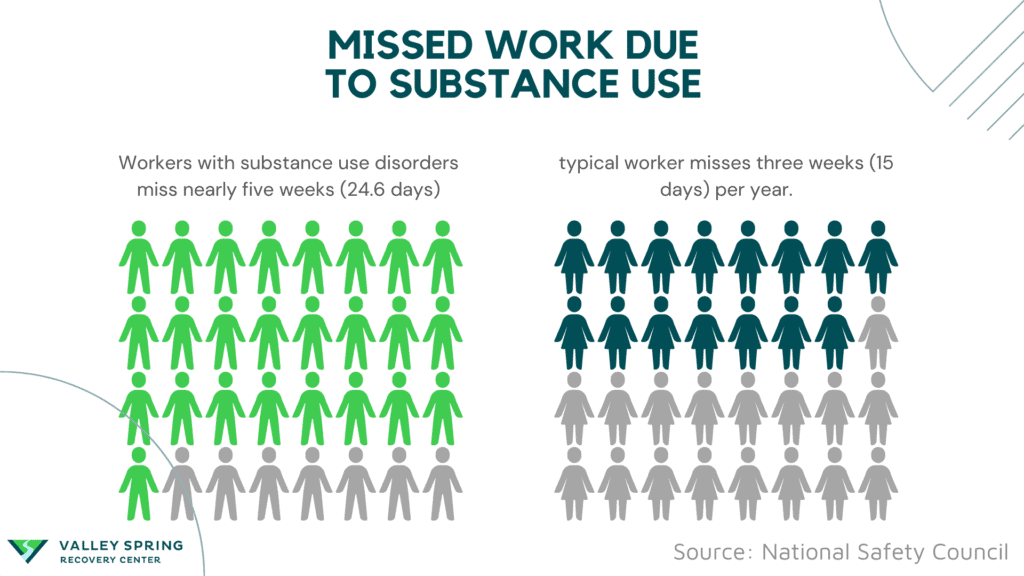
Substance abuse in the workplace leads to significant safety concerns, lost productivity, and increased healthcare costs, costing businesses approximately $81 billion annually. Nearly 70% of individuals using illegal drugs are employed, contributing to absenteeism, decreased productivity, and higher rates of occupational injuries. Implementing drug-free programs, investing in treatment, and humanizing workplace policies can mitigate these impacts and enhance overall workplace environment.
- Workplace Safety Concerns: Implementing drug-free workplace programs can address safety concerns and promote a drug-free environment.
- Healthcare Costs: An estimated $25 billion is spent each year on healthcare costs related to drug abuse in the US.
- Total Cost to Employers: Lost work, healthcare costs, and lost productivity cost businesses $81 billion annually.
- Lost Productivity and Absenteeism: Drug abuse leads to an estimated loss of $25.5 billion each year due to absenteeism and decreased productivity.
- Drug Users in the Workforce: It’s estimated that 70% of Americans who use illegal drugs are currently employed.
- Theft at Work: A 1994 publication found that 80% of drug abusers supported their drug use by stealing from their work.
- Cost to Organizations: Alcohol and drug use disorders cost American businesses an average of $81 billion in lost profits annually due to productivity losses, high turnover rates, theft, absenteeism, and decreased quality of work.
- Functioning Employees: More than 70% of individuals with alcohol or illicit drug use continue to maintain employment, but over 42% report a decrease in productivity.
- Occupational Injuries and Fatalities: Alcohol and drug use increase the number of occupational injuries and fatalities. Alcohol was detected in 16% of emergency room visits for workplace-related injuries, and over 10% of workplace fatalities involve alcohol.
- Creating a Drug-Free Environment: Employers can create a drug-free work environment through education, clear policies, drug testing programs, and Employee Assistance Programs (EAPs).
- Investment in Treatment: Treatment for addiction facilitated by the workplace has shown success in improving employees’ functioning and decreasing absenteeism, with an estimated gain of 23% to 64% depending on income levels.
- Humanizing the Workplace: Organizational involvement is shifting from punishment to providing education and resources, humanizing the workplace, and reducing suffering.
- Missed Work: Workers with substance use disorders miss nearly five weeks (24.6 days) a year, compared to the typical worker who misses three weeks (15 days). Workers in recovery miss the fewest days at 10.9 days.
- Job Turnover and Re-training: The base cost of recruiting and training replacement workers is one-third of a worker’s annual salary, with total costs over 50%. Workers with an untreated substance use disorder cost an employer more than $14,000 a year.
- Health Care Costs: The U.S. spends about $35 billion a year to treat substance use disorders and $85 billion annually for associated injuries and illnesses. The average hospital-paid claim per day in 2018 was $2,517.
- Employees and Dependents Affected: Almost 9% of working adults have a substance use disorder. Employees with family members dealing with addiction may face financial problems, legal consequences, and lost productivity.
- Industries Affected: Higher rates of substance use disorders are found in industries with younger, male-dominated workforces, like construction, entertainment, and food service.
- Economic Impact: Excessive drinking, particularly binge drinking (defined as more than four drinks for women or more than five for men), cost the U.S. economy nearly $250 billion in 2010.
- Personal Savings: The article highlights the personal savings of not drinking alcohol, with the example of a person’s bill being consistently 50% cheaper without cocktails or beers.
- Lower Productivity: Excessive drinking doesn’t just result in a high bar tab; it also lowers productivity, contributing to the economic cost.
| Aspect | Detail |
|---|---|
| Workplace Safety Concerns | Implementing drug-free workplace programs can promote safety and a drug-free environment. |
| Healthcare Costs | Annually, $25 billion is spent on healthcare costs related to drug abuse in the US. |
| Total Cost to Employers | Lost work, healthcare costs, and lost productivity cost businesses $81 billion annually. |
| Lost Productivity and Absenteeism | Drug abuse causes an estimated annual loss of $25.5 billion due to absenteeism and decreased productivity. |
| Drug Users in the Workforce | Approximately 70% of Americans who use illegal drugs are employed. |
| Theft at Work | A 1994 publication found that 80% of drug abusers steal from their work to support their drug use. |
| Cost to Organizations | Alcohol and drug use disorders cost American businesses $81 billion annually in lost profits due to productivity losses, high turnover rates, theft, absenteeism, etc. |
| Functioning Employees | More than 70% of individuals with alcohol or illicit drug use maintain employment, but over 42% report decreased productivity. |
| Occupational Injuries and Fatalities | Alcohol and drug use increase occupational injuries and fatalities; alcohol was detected in 16% of ER visits for workplace injuries, and over 10% of fatalities involve alcohol. |
| Creating a Drug-Free Environment | Employers can use education, policies, drug testing, and EAPs to create a drug-free work environment. |
| Investment in Treatment | Workplace-facilitated addiction treatment can improve employee functioning and decrease absenteeism, with gains of 23% to 64% depending on income levels. |
| Humanizing the Workplace | Shifting organizational involvement from punishment to education and support, reducing suffering. |
| Missed Work | Workers with substance use disorders miss nearly five weeks a year, compared to three weeks for typical workers; those in recovery miss the fewest days. |
| Job Turnover and Re-training | The base cost of recruiting and training replacement workers is one-third of a worker’s annual salary, with untreated substance use disorders costing over $14,000 a year. |
| Health Care Costs | The U.S. spends about $35 billion a year on treating substance use disorders and $85 billion on associated injuries and illnesses. |
| Employees and Dependents Affected | Almost 9% of working adults have a substance use disorder, affecting finances, productivity, and legal issues for those with addicted family members. |
| Industries Affected | Higher rates of substance use disorders in industries with younger, male-dominated workforces, like construction, entertainment, and food service. |
| Economic Impact | Excessive drinking, particularly binge drinking, cost the U.S. economy nearly $250 billion in 2010. |
| Personal Savings | Not drinking alcohol can significantly reduce personal expenses, with bills being 50% cheaper without cocktails or beers. |
| Lower Productivity | Excessive drinking lowers productivity, contributing to the economic cost. |
Substance abuse in the workplace not only undermines individual health and safety but also imposes a substantial economic burden on businesses, with costs estimated at $81 billion annually. This encompasses everything from safety concerns and healthcare costs to lost productivity and absenteeism. It’s vital that employers recognize these challenges and implement robust drug-free programs, invest in effective treatments, and foster supportive policies that not only mitigate these impacts but also enhance the overall workplace environment.
Dr. Michael Olla, Medical Director and Psychiatrist at Valley Spring Recovery Center
What Industries and professions have the highest rate of addiction?
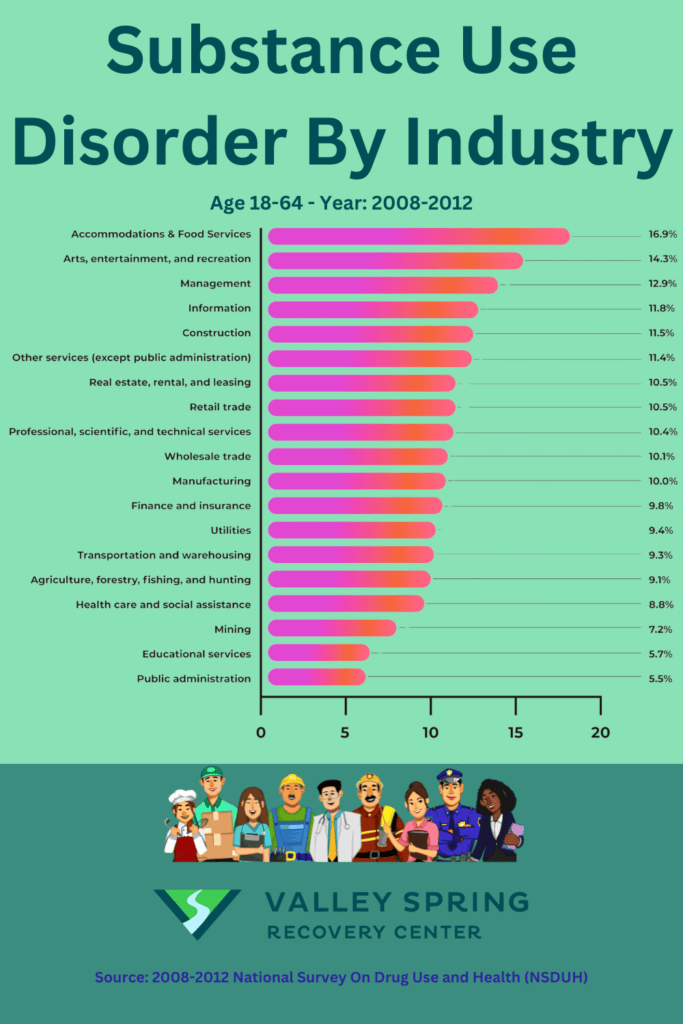
The prevalence of substance use disorders varies significantly across different industries. The highest rates were found in the construction industry at 16.5%, while the lowest were in the education services industry at 4.3%. Recognizing these differences can help in targeting interventions where they are most needed.
1. Healthcare Professionals
- Substance Misuse Among Health Care Professionals (HCPs): Substance misuse and addiction rates are no different among HCPs than in the general population, but HCPs demonstrate significantly higher levels of opioid abuse.
- Patterns of Addiction: Studies in the U.S. have shown that 10%–15% of HCPs will misuse substances during their lifetime, with rates of prescription drug abuse and addiction 5 times higher among physicians than in the general population.
- Opioid Misuse: The rate of opioid misuse among HCPs is much higher than in the general population, possibly due to increased access to prescription drugs, high work-related stress, exposure to illness, death, trauma, and sleep deprivation.
- Treatment Challenges: HCPs are often underevaluated and undertreated for addiction and substance abuse due to fear of negative social, professional, legal, or financial consequences.
- Specialized Treatment Programs: HCP-specific treatment programs are critical, as they provide more intensive treatment and continuing care plans, addressing professional licensing, private practice, medical reputations, and other unique areas.
- High Success Rates: HCPs demonstrate some of the highest success rates in any specialized population, with 81% maintaining sobriety for five years post-treatment. Monitoring with random drug tests has proven effective in maintaining high abstinence rates.
- Implications for Patient Safety: Untreated substance abuse and addiction among HCPs can lead to serious safety issues for the patients they treat, requiring more intensive treatment than the general population.
2. Lawyers
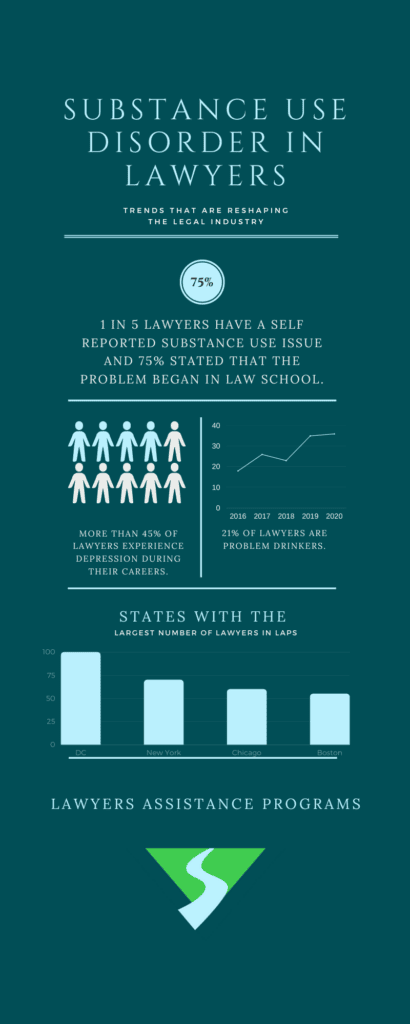
- Problematic Drinking: 20.6% of lawyers scored at a level consistent with problematic drinking.
- Depression: 28% of attorneys reported experiencing mild or higher levels of depression, with 46% reporting concerns with depression at some point in their careers.
- Anxiety: 19% of lawyers reported experiencing mild or higher levels of anxiety, with 61% reporting concerns with anxiety at some point in their careers.
- Suicidal Thoughts and Behaviors: 11.5% of attorneys reported suicidal thoughts during their career, 2.9% reported self-injurious behaviors, and 0.7% reported at least one prior suicide attempt.
- Comparison with Other Workforces: In comparison, 11.8% of a broad, highly educated workforce screened positive on the same measure for problematic drinking.
- Rates Higher for Younger Attorneys: Rates of problematic drinking and mental health concerns were higher among younger, less experienced attorneys.
- Barriers to Seeking Help: The top barriers to seeking help amongst attorneys are concerns over privacy or confidentiality and not wanting others to find out they needed help.
3. Construction Industry
With a rate of 16.5% for SUDs, the construction industry has one of the highest prevalences of substance abuse. The physically demanding nature of construction work and often transient employment might contribute to this higher rate.
- The highest rates of past month heavy alcohol use among full-time workers aged 18 to 64 were found in the mining (17.5 percent) and construction industries (16.5 percent). (SAMSHA)
- 12% have an alcohol use disorder compared to 7.5% nationally. (American Addiction Centers)
- 16.5% of construction workers reported heavy alcohol consumption within the past month, nearly twice the average of all full-time workers surveyed. (American Addiction Centers)
- 11.6% of construction workers reported illicit drug use within the past month (American Addiction Centers)
- 14.3% of construction workers were diagnosed with a substance use disorder in the past year, more than 1 ½ times the average of all full-time workers surveyed. (American Addiction Centers)
- 2.3% have a marijuana use disorder. (American Addiction Centers)
4. Food Service Industry
Restaurant workers, including chefs and servers, might be exposed to a culture where alcohol consumption is normalized. The irregular hours and stressful work environment can contribute to increased rates of SUDs in this industry.
- The highest rates of past month illicit drug use were found in the accommodations and food services industry (19.1 percent). (SAMSHA)
- The workers in the accommodations and food services industry (16.9 percent) had the highest rates of past year substance use disorder. (SAMSHA)
5. Law Enforcement
Police officers and other law enforcement professionals face a unique set of stressors, including exposure to trauma and high-stress situations. Substance use disorder is significantly prevalent within the law enforcement community, with estimates suggesting that one in four police officers may struggle with alcohol or drug abuse issues. This rate of substance use disorders among police officers is estimated to range between 20% and 30%, which is notably higher than the under 10% prevalence in the general population according to Psychology Today.
The nature of police work, which often involves high-stress, life-threatening situations, and exposure to traumatic events, contributes significantly to this increased risk. Moreover, the law enforcement culture and the stigma associated with seeking help for mental health issues further exacerbate the problem, making it challenging for officers to seek and receive treatment. Treatment strategies that integrate the officer’s work environment and stressors are more effective, suggesting a need for tailored approaches to address substance use disorders within this population. This perspective is supported by insights from the Hazelden Betty Ford Foundation and Retreat Behavioral Health, which also emphasize the complexity of addressing substance use within the law enforcement community due to unique job-related stressors and cultural factors.
6. Mining Industry
The SAMHSA report from 2008 to 2012 shows that the mining industry has the highest rate of past month heavy alcohol use among full-time workers aged 18 to 64, at 17.5%. However, it has a relatively lower rate of past month illicit drug use at 5.0%. These statistics highlight the particular challenges related to substance use within the mining sector, underlining the need for targeted health and safety interventions.
7. Technology Sector
The fast-paced nature of the tech industry and the pressure to meet deadlines might lead to the misuse of stimulants to enhance productivity. Long working hours and high stress can also contribute to substance abuse.
The Technology Sector (Information Industry) has shown a significant presence of illicit drug use at 11.7% among employees.
8. Education Services
Education Services exhibits low levels of substance use with only 4.7% engaging in heavy alcohol use and a 5.5% rate of substance use disorder.
Though it has one of the lower rates of SUDs, teachers and other educational professionals are not immune to substance abuse. Stressors such as dealing with behavioral issues and administrative pressures might lead to substance use disorders.
9. Transportation
Truck drivers, pilots, and others in the transportation industry might turn to substances to combat fatigue or deal with the loneliness and stress of long hours on the road or in the air.
The Transportation sector has an 8.8% rate of heavy alcohol use among its workforce.
10. Entertainment Industry
Performers, musicians, and others in the entertainment field might face pressures that lead to substance abuse, such as performance anxiety or the normalization of drug and alcohol use in certain subcultures within the industry.
The entertainment industry is notable for higher substance use rates, with 13.7% of workers using illicit drugs and a 12.9% substance use disorder rate.
What Are The Age and Gender Differences as it pertains to Workplace Addiction?
Younger workers, those aged 18 to 25, had higher rates of past-year SUD at 14.3%, compared to those aged 26 to 34 at 10.6%, and those aged 50 to 64 at 6.3%. Additionally, males had higher rates of past-year SUD at 9.5% compared to females at 7.7%. These disparities highlight the need for tailored approaches to different demographic groups.
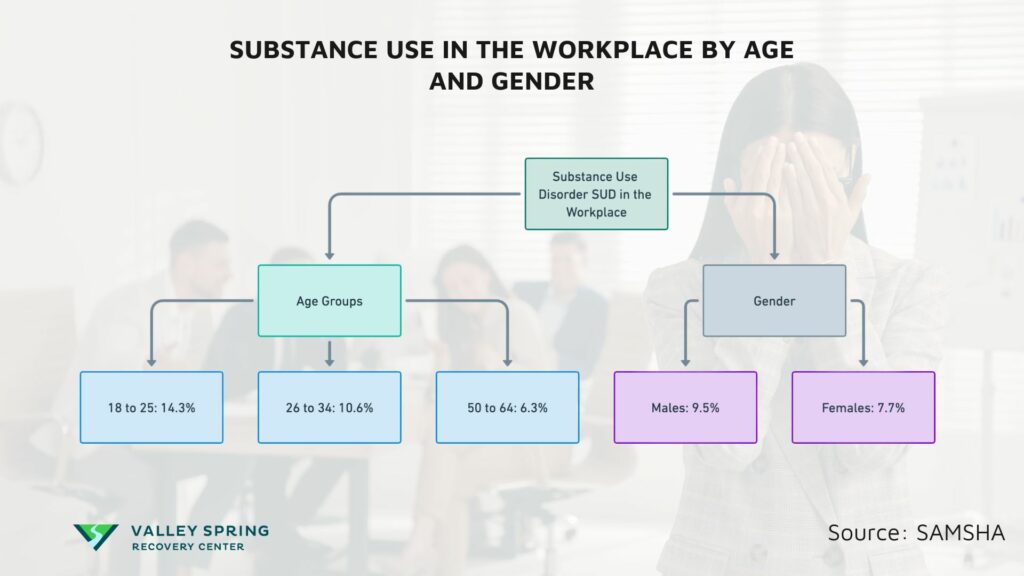
What Are The Causes Of Substance Use In The Workforce?

While no employer would want to consider that they might be a part of the problem, in some instances, the workplace could be a contributing factor in substance use. In offices where drinking or drug use is tolerated, early warning signs may easily be overlooked. The availability of alcohol in the office may seem acceptable to some, but even casual drinking can be instrumental in leading to alcoholism, particularly when there is no supervision.
Some industries may put staff in contact with potentially addictive substances, which accounts for the increasing occurrences of healthcare professionals requiring addiction treatment. The combination of pressurized environments and access to addictive medications can be a problem. On the other end of the spectrum, jobs that are boring, lacking in human contact, or highly stressful can also lead employees toward addiction. These risks are further increased when staff are faced with sexual harassment, verbal or physical abuse, or poor treatment from colleagues or superiors.
What Are The Signs Of Substance Use Disorder?
Of course, not all addiction is work-related, but with 70% of people with an addiction holding down jobs, it is inevitable that these problems will manifest in the work environment. While some employees are easy to identify as substance users, others may be high-functioning users who maintain regular careers despite their alcohol or drug addiction. There are some common tell-tale signs that an individual may be abusing drugs or alcohol, these include:
Poor Hygiene or Appearance
- Mood Swings and Lack of Motivation
- Problems with Relationships or Personal Life
- Persistent Financial Problems
- Absenteeism for Vague Ailments or Family Issues
- Disregard for Commitments or Assignments
- Poor Concentration or Memory Lapses
Preventative Measures
Employers can manage substance use in the workplace through various preventative measures. Implementing a company policy forbidding the use of drugs and alcohol at work is a useful preliminary step. However, it is also positive to promote a culture of health and well-being in the workplace, focusing on job satisfaction and proactive management of work-related stress.
Providing education on drug addiction and alcoholism can empower employees to make healthy decisions or identify co-workers who may be in trouble. Encouraging open communication around drug or alcohol use may also allow staff to step forward if they believe they have a problem or suspect a colleague is in need of assistance. Furthermore, studies indicate that workplaces offering a supportive, drug-free environment are more likely to discourage a relapse for those recovering from addiction. Additional methods may include regular alcohol or drug testing, with companies conducting mandatory screening administered according to federal regulations for workplace drug testing programs.
Protocols should be drafted around managing circumstances where positive test results arise, with employers needing to be cognizant of the sensitivities involved. Since the inception of Employee Assistance Programs (EAPs) around fifty years ago, an increasing number of companies have opted to implement these structures to manage such situations. As many as 77% of US companies now offer support to employees through an EAP.
HOW WORKPLACE PROGRAMS CAN HELP
EAPs can play a vital role in assisting employees suffering from alcoholism or drug addiction. Short-term counseling or helping staff connect with suitable peer support or recovery groups can be beneficial.
In many cases, people with addiction may be reluctant to attempt treatment for fear of losing their employment. Valley Spring Health’s Outpatient Treatment Services offer programs designed to provide executives with access to work duties where possible, thereby minimizing interruption to professional responsibilities. By educating employees about their healthcare rights and advising them of their available options, EAPs may help overcome any reluctance, giving the employee access to the care that may ultimately lead them toward successful substance abuse treatment.
Night Time Counseling: A Lifeline for Working Professionals
For working professionals grappling with substance use disorder, the demands and pressures of their job often intertwine with the challenges of recovery. Night-time counseling provides an invaluable lifeline, offering flexibility that aligns with their busy schedules. This tailored approach ensures they don’t have to compromise their professional commitments while seeking help. Moreover, sessions after regular working hours can be particularly potent, addressing the vulnerabilities that evenings might bring, such as increased cravings or feelings of isolation. Night-time counseling stands as a testament to the importance of accessible care, acknowledging that recovery doesn’t fit a standard 9-to-5 mold.
Help Is Available
Substance use disorders are not confined to one particular industry or profession. Factors such as stress, access to substances, workplace culture, and the physical demands of the job can all contribute to the development and prevalence of SUDs. Understanding the unique risks and pressures faced by individuals in different occupations is crucial for developing targeted prevention, education, and intervention strategies. The emphasis on creating a supportive workplace culture, implementing appropriate policies, and encouraging employees to seek help if needed can go a long way in promoting a healthy and productive work environment across all industries.
At Valley Spring Drug and Alcohol Rehab Center, we form and develop professional relationships in the form of partnerships and assistance programs to support employers, unions, and other professional associations wanting to offer addiction treatment to their workforce, union members, and patients.
Sources
Substance Abuse and Mental Health Services Administration. (2016). Substance Use and Substance Use Disorder by Industry. SAMHSA, U.S. Department of Health & Human Services. Link to the report.
White, G. B. (2015). Hangovers: They’re Costing the U.S. Economy. The Atlantic. Retrieved February 13, 2020, from The Atlantic.
National Safety Council. (n.d.). Implications of Drug Use for Employers. Retrieved February 13, 2020, from National Safety Council.
Ingraham, C. (2015). The Jobs Most Likely to Make You Drink. The Washington Post. Retrieved February 13, 2020, from The Washington Post.
Harvard Medical School. (2017). Working on Addiction in the Workplace. Retrieved February 13, 2020, from Harvard Health.
US Drug Test Centers. (n.d.). The Cost of Drug Abuse in the Workplace. Retrieved February 13, 2020, from US Drug Test Centers.
American Bar Association & Hazelden Betty Ford Foundation. (2019). The Prevalence of Substance Use and Other Mental Health Concerns Among American Attorneys. [Infographic]. Retrieved from American Bar Association.
Butler Center for Research. (2015). Health Care Professionals: Addiction and Treatment. Hazelden Betty Ford Foundation. Retrieved from Hazelden Betty Ford Foundation.
Dr. Michael Olla
All author postsShare This Post

